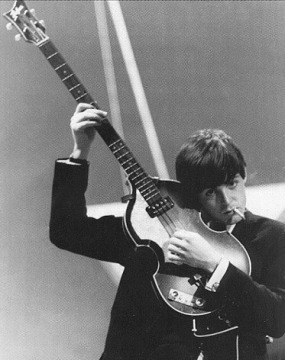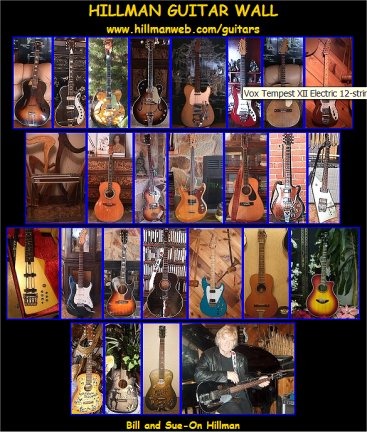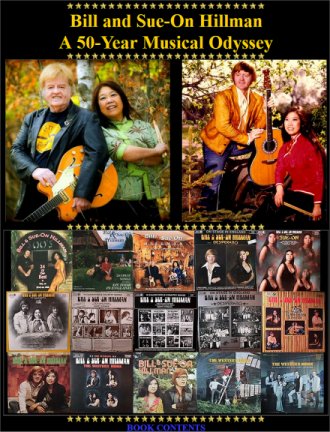PART 2 Part 2, General
Model Info.
Introduction
In the gripping first episode of the Höfner saga, we threatened to
provide more
detailed information on Hofner's model numbering system. In the absence
of
inducements to forget about the whole thing, we have prepared the following
guide to
Hofner models.
General Model Information
Selmer imported several Hofners into the U.K. that were very similar to
German
models. And Sorkin imported German model Hofners into the U.S. Listed in
this
article are decriptions of German models from the late ‘50’s/early ‘60’s,
with an
indication of the parallel Selmer models. Unlike guitars produced for European
consumption, Selmer Hofners had labels, indicating model names and serial
numbers.
The Germans used model numbers instead of names and did not use serial
numbers
on non-export instruments until the ‘70’s. They also replaced big mother
of toilet seat
block markers with dot markers on some guitars, changed headstocks and
binding
schemes, altered models for export, and smoked like fiends.
So figuring out the fine details, like when changes were made to specific
models, or
when models were added or discontinued, is difficult without reference
to old (and
unreliable) catalogues from specific years. Hey, just call me a big picture
kinda guy.
The design and construction of Hofner archtop guitars evolved considerably
from the
early ‘50's to the late ‘60's, parroting trends in North America. Just
like Gibson,
Epiphone and Guild, Hofner designed its product offering around a few guitars
that
could be decorated and modified to support the perception of a broad product
offering. In addition to different trim levels (each with its own model
number), various
Hofner’s archtop guitars were at different times offered with:
full-body or cutaway styles
blonde or brunet (sunburst) finishes
deep body or thinline styles
various pick-up configurations.
optional Bigsby vibrato units and DeArmond pick-ups
optional Bigsby-derived Hofner vibrato units
tacky on-board active electronics on some models.
Following is a review of the features of these guitars. The information
comes from a
variety of Hofner catalogues, The Hofner Guitar - A History (by Gordon
Giltrap and
Neville Marten) , Electro-Gitarren Made in Germany (by Norbert Schnepel
and
Helmut Lemme), Hofner Guitars Made in Germany (by Michael Naglav) and
personal observation of hundreds of Hofner guitars.
Hofner had been building guitars since 1925, and started to build guitars
after WWII
at the beginning of 1947. They moved to a new building in Bubenreuth in
1951. In the
early ‘50’s, there were several archtop guitar models:
455, 456, 460, 462, 463, 464, 465, 468
By the mid-’50’s, the model range had widened considerably, and from then
to the
mid-’60’s was Hofner’s heyday, during which period they offered a wide
range of
archtop guitars. Hofner also offered a variety of other guitars as well,
including
classical guitars, steel string flat-tops, lapsteels, solidbodies, short-scale
bass guitars
and compact archtops. The only non-archtop of any interest to me is the
Model 499,
which was like a Gibson J-185 decked out to resemble a Hofner Model 468
archtop. This article reviews only the archtop and compact archtop guitars,
including:
125, 126, 127, 128,
449, 450, 455, 456,
457, 458, 459, 460,
461, 462, 463, 464,
465, 468, 470, 471
During this period, hardware such as tuners, pick-ups and wiring harnesses
changed
and improved. However, the maze of slightly different-looking Hofners is
actually
quite simple to decode, even with partial information, based on consumption
of
several shots of Wilhelmina and an analysis of features related to:
Guitar
Body Dimensions - widths, depth, length
Body Woods
Neck Woods
Fingerboard Styles / Woods / Inlays
Peghead Shapes
Peghead Overlay Styles
Bindings and Purflings
F-holes
Hardware
Tuning Machines
Bridges
Tail-pieces
Pick-ups
Pickguards
Controls and Control Configurations
Potentiometer Date Codes
The potentiometers of electric Hofners can be used to date instruments
from about
1958 onwards. Prior to that time, Hofner used solid shaft pots with cylindrical
metal
bodies, the ends of which comprise composite material out of which lugs
protrude.
These have resistance values indicated typically at 250k, but no date codes.
Hofner started using "Preh" branded pots with cast bodies in about 1958,
capped
with square composite ends out of which lugs protrude. The composite material
is
stamped with the pot value (typically 250k) and a date code. One great
feature of
these pots was the inclusion of eyes at each of the corners to allow for
easy solder
connections for grounding.
The date code had either two or three numbers. The last digit refered to
year, and the
preceding digits refered to week. So 295 was the 29th week of 1965, 501
was the
50th week of 1961, and 89 was the 8th week of 1959 ( or 1969, but other
features
make it obvious which decade applies).
Truss Rods/Covers
Hofner started using adjustable truss rods in 1960. Access was at the headstock,
Gibson-style, using a hex nut adjustment. By the end of the ‘60’s, the
hex nut was
replaced with an allan nut. Truss rod covers evolved as well, from a style
with two
smooth curves reaching a top point, done in 2-ply w/b plastic (with a thin
black top
layer) or white mother-of-toilet-seat (solid or over a white layer) to
a pear-shaped
style with a bulge on either side at the bottom (usually done in b/w/b
plastic).
Guitar Top Dates
Hofner provided useful dating information: dates were often written on
the undersides
of the tops, and may be found using a dental mirror, some illumination
and a lot of
patience. I was quite delighted when I first stumbled upon such a handwritten
date
while visiting the interior of an old Hofner.
This information is found between the treble strut and the treble f-hole,
although it
sometimes appears between the bass strut and the bass f-hole. I have observed
dates
hand-written in pencil, ink, as well as stamped in blue ink.
Inventory Philosophy
Hofner continued to use old hardware inventory after the introduction of
new
hardware features, so many examples exist that have combinations of old
and new
features. New pick-ups were introduced on top-of the line instruments and
trickled
down the models. As well, especially among the 450, 455, 456 and 457 (and
perhaps because of their similarities), many hybrid guitars were built,
such as a 456
with a 457 neck, or vice-versa. This may have been due to experimentation,
model
changes, lack of correct inventory, backorders or plain carelessness.
How old is that Hofner in the Window?
This information, combined with a basic understanding of the different
model features,
makes it easy to identify old Hofners.
Tuning Pegs
Going through the models from simple to fancy, Hofner used a variety of
tuners.
Open-back strip tuners came on brass plates, with small white plastic buttons,
usually
squared off in appearance, and cheap pressed metal bushings. Nickel-plated
plates
also appeared. Buttons were made of white plastic or mother-of-toilet -seat.
Individual open-back tuners on nickel-plated plates appeared on better
models, with
larger squared-off buttons and high-quality machined bushings. These plates
had
parallel sides with a floral profile at top and bottom. Fancier tuners
used similar
plates, but with more elaborate buttons, moulded with the same floral reference.
Top
of the line tuners were gold-plated, covered, and with elaborate chasing
and the same
elaborate mother-of- toilet-seat buttons. The fanciest tuners were manufactured
by
Kolb, and were also used on Hagstrom and Guild guitars.
In the early ‘50’s, even the fanciest guitars used strip tuners (often
elaborately
chased) that resemble classical guitar tuners. The shafts of these tuners
were metal,
wrapped with white plastic sleeves (of classical guitar dimension) with
oversized brass
bushings. These sleeves were soon eliminated and shaft diameters were reduced
to
conventional diameters by the mid-’50’s. In general, shaft diameters on
the better
tuners were 7mm, wider than the 1/4" shafts found on American tuners by
Kluson,
Grover or Waverly (except for Kluson Seal-Fasts or Grover Imperials, which
hover
around 5/16").
In the mid-‘60's, Hofner introduced covered tuners, with plain rectangular
metal,
white or mother- of-toilet-seat rectangular buttons. These tuners were
nickel-plated,
or goldplated on the top models.
In general, Hofner arched-top guitar headstocks were thicker than comparable
American guitar headstocks, so the tuners had extra-long shafts. Other
than original
tuners, Schallers are the only currently available tuners with long enough
shafts to
routinely provide adequate clearance.
Wiring Harnesses
Pick-up controls were originally mounted on single-layer mother-of-tortoiseshell
plates mounted on the bottom bout, on the treble side. On/off switches
(black plastic
switches, aluminium surrounds) for each pick-up were located below the
mounting
plate, right near the edge of the guitar. One pick-up guitars utilized
a circular plate,
typically with single volume and tone knobs. Two pick-up guitars used a
larger, oval
mounting plate, typically with two volume knobs and two tone knobs in a
"cloverleaf"
array. The plates were decalled in English with "Volume" and "Tone" in
gold, and had
bevelled edges finished in white paint. Knobs were of the "teacup" variety.
In the late ‘50's, these plates were replaced by the classic "radio control"
rectangular
plates, with two volume knobs and three switches, so familiar to Beatle
bass
aficionados. The plates were single-layer mother-of-tortoiseshell, also
edged with
white paint, with white "teacup" knobs and white switches. Single pick-up
control
plates had only a single knob and three switches. White mother-of toilet-seat
plates
with black painted edges were also used and became the norm into the ‘60’s.
In the ‘60’s, many of these control plates were replaced with pots mounted
directly
through the face of the guitar, usually in rows of three or in Gibson-style
2+2 format.
Finally, pick-up switches appeared, usually in the upper bass bout. The
switch had a
flimsy black plastic tip in a rectangular black metal housing attached
to the guitar top
with two screws.
Knobs
Hofner teacup knobs were off-white, with concave gold caps pressed into
the tops.
There were two versions, one with a rounded top lip, one with a bevelled
top lip.
Very old teacup knobs also appear in tortoiseshell.
Hofner skirted knobs, introduced in the ‘60’s, had grooves in the skirt,
concave
nickel or gold tops pressed into place, and VOLUME or TONE deeply embossed
on their surfaces. Skirted knobs also appeared in black occasionally. They
looked
somewhat like a combination of ‘60’s Fender Stratocaster and Fender amp
knobs.
Original Hofner knobs were attached with slot head set screws, and were
cast to fit
Hofner solid shaft pots, which were 6mm in diameter. They do not fit on
American
1/4" solid shaft pots unless the knobs are drilled out.
Screws
In the ‘50’s and ‘60’s, Hofner used slot head screws. They often used round
headed
nails to secure tailpieces. Around 1964, they started to use black Phillips
head screws
to attach truss rod covers and to attach Gibson-style pick-up mounting
frames to
guitar faces.
Pickguards
Hofner developed a distinctive pickguard shape for its non-cutaway as well
as its
cutaway guitars, For the most part, pickguards were either thick one ply
white
mother-of-toilet-seat, or thick one- ply tortoiseshell, although other
types occur, such
as two-ply white mother-of-toilet-seat over white, or two-ply brown
mother-of-toilet-seat over white. On the fanciest guitars, the pickguards
were clear
acrylic. The pickguards usually had chamfered edges.
In the ‘60’s, Hofner started using b/w/b/w/b pickguards with chamfered
edges, again
more closely resembling Gibson in choice of material. The clear pickguard
featured
on the top models was now routed for a wide pinstripe and a Hofner logo,
filled with
gold detailing.
Hofner attached its pickguards at three points, so the plastic never came
into contact
with the guitar tops. Common finishing nails were used to attach pickguards
at two of
those points: a small hole was drilled at the side of the neck and another
on the base
of the bridge. The nail was sandwiched between the pickguard and a small
piece of
pickguard material glued underneath. This wonderfully shoddy approach is
part of the
charm of these guitars. On the top of the line guitars, the clear pickguard
was
attached to the neck and bridge with neat little pins drilled right into
the side of the
pickguard.
A bent metal bracket was attached to the guitar side with a single screw
running
through a countersunk hole in the bracket. With most pickguards, the bracket
was
friction fit to the underside of the pickguard through a slot made of glued-up
pickguard material. With clear pickguards found on the fanciest models,
the bracket
was attached to the pickguard with a single nut and countersunk bolt.
In the late ‘60’s’, Hofner adopted a new "reverse" pickguard shape, following
the
contours of the guitar cutaway, the idea for which came from the "Beatle
bass"
pickguard. Originally mounted like the older pickguards, they were eventually
mounted directly onto the guitar face with countersunk philips head screws,
with small
risers to raise the pickguard off of the face of the guitar.
Plating
Hofner generally used nickel-plated metal parts except for its top of the
line guitars,
which used gold-plated parts. Hofner started to use chrome-plated parts
in the
mid-’60’s, on its own vibrato tailpieces, metal bridges and "nova-sonic"
humbucking
pick-ups (usually refered to as "staple" pickups).
Pick-ups
Pick-ups went through several changes manufactured by Fuma in Berlin; single-coil,
with six multi-slot screws on chrome-plated metal bodies riveted to matching
non-adjustable chrome-plated bases
Hofner single coil pick-ups with rosewood bodies and black plastic caps,
mounted
on matching rosewood bases with height-adjustable knurled aluminium rings
on
aluminium posts
Hofner single coil pick-ups with all-plastic cases, usually black, sometimes
white,
mounted on matching bases with height-adjustable knurled aluminium rings
on
aluminium posts
Hofner single coil pick-ups with slotted metal covers, nicknamed "toaster"
pick-ups,
mounted in thick black plastic rings. Height adjustment was through double
set
screws threaded directly through the bass and treble sides of the plastic
ring, directly
holding the pickup. The rings were attached to the guitar body with two
countersunk
screws through two tabs on the treble and bass sides of the rings, hidden
from view
by the pickups themselves. This meant that the rings had to be attached
to the bodies
first, then the pickups installed. No holes were cut into the guitar faces
as a result, but
for small holes drilled to allow pickup wires to pass through the guitar
tops.
Hofner single coil "super-response" pick-ups with six exposed slot-head
screws and
the Hofner logo in a rhombus stamped on the faces (the Hofner logo facing
either
toward or away from the screws depending on whether it was a neck or bridge
pick-up). These were larger than the "toaster" pick-ups, and were mounted
in
thinner-walled black plastic rings. Height adjustment was again through
double set
screws threaded directly through the bass and treble sides of the plastic
rings, directly
holding the pickups.
Different ring heights were used depending on pickup placement at the neck
or
bridge, and different pick-up heights were also used, particularly on the
"Verithin"
model guitar. The rings were attached to the guitar bodies with two countersunk
screws through two tabs on the treble and bass sides of the rings, hidden
from view
by the pickups themselves. This meant that the rings had to be attached
to the bodies
first, then the pickups installed. No holes were cut into the guitar faces
as a result, but
for a small holes drilled to allow the pickup wires to pass through the
guitar tops.
Hofner "nova-sonic" humbuckers with chrome covers. These had the same six
slot
screws as the "super-response" units, but opposite each screw was an exposed
rectangular "staple", hence the nickname "staple pick-ups". These pickups
had the
same dimensions as the "super-response" pickups, and were mounted the same
way
on early examples, but were introduced right around the time when Hofner
changed
its pick-up mounts.
The new humbucking pickup-style system had the pickups suspended from
Gibson-style black plastic rings by two spring-loaded, slot-head machine
screws with
squared-off tops. The rings were attached to the guitar bodies with four
black
countersunk Philips head screws at each corner of the rings. This meant
that tops of
the guitars had to be cut under the mounting rings to allow the pickups
to hang
properly.
This affected the construction of Hofners in that the struts, which had
previously been
glued to the underside of the top in a v-shaped configuration, converging
toward the
neckblock, were eventually replaced with parallel struts, spaced widely
enough apart
to accommodate the holes in the top now required for proper pickup installation.
But
the change in strut placement took place well after the change in mounting
ring styles,
so one sees many guitars from the mid-‘60’s with crudely cut holes that
leave the
struts exposed, or cut partially through them. The crudeness of these transitional
installations speaks volumes about the state of Hofner’s archtop production
in the
mid-‘60’s.
Hofner bar pick-ups with a solid blade in a black plastic surround set
into the
chromed cover. The blade was notched below the B string and there were
six
adjusting screws set in the chrome cover near the pick-up edge. There were
two
versions of this bar pick-up, one of which fits into the existing Hofner
pick-up
mounting rings, the second of which was longer and narrower, and fit into
very
cheesy-looking oversized mounting rings.
These were followed by humbuckers which increasingly came to resemble Gibson
pick-ups.
In addition to these pickups, Hofner also offered a variety of after-market
pick-ups in
the late 1950’s to retrofit onto acoustic archtop guitars.
Bridges
Hofner used several bridge assemblies. They had wooden bases, with knurled
aluminum wheels on aluminum posts, on which sat wooden bridges. By the
late ‘50’s,
there were several different types of bridges for "cello-guitars":
Ebonized (dyed maple), with fret (bone or white plastic insert) , height
adjustable with 2 screws. This was the basic bridge. The "fret" or insert
was
set in diagonally across the top. I have also seen ebony and rosewood versions
of this style.
Ebony or rosewood, with moveable fretwire, height adjustable with 2 screws.
This was the classic Hofner bridge, with four open slots, separated at
the ends
with white plastic, into which were friction-fit pieces of fret-wire that
could be
moved between slots to optimize intonation.
Ebony, adjustable, with celluloid and mother-of-pearl inlay ( I have yet
to see
one).
Standard rosewood or ebony two-piece bridge, similar to those found on
Gibson or Guild archtops (Guild used a lot of German hardware - their
wooden bridges were probably German as well)
Several other good quality bridges were subsequently used as well. In the
early ‘60’s,
Hofner introduced the "micro-matic" bridge, which was a version of Gibson’s
"tune-o-matic" bridge, and sat on a height-adjustable rosewood base.
Hofner also introduced some really stupid bridges. One design used adjustable
white
plastic inserts which slid along channels in the top piece of the rosewood
bridge. This
bridge was not so bad, but the design was subsequently copied in black
plastic, and
appeared on many cheaper Hofner archtops. It stained the top black under
its feet,
and had extremely poor tone transmission qualities. Hofner also introduced
a
distinctive chromed or gold-plated metal bridge with adjustable clear plastic
inserts
that could be intonated by being slid along a metal channel, all on a solid
black dyed
maple base. Ugh!
Necks
Hofner used maple for its necks. Most Hofner necks had glued-on heel extensions,
although one occasionally finds ‘50’s necks profiled using single pieces
of wood.
Early necks had a shallow headstock pitch, which was changed in the mid-’50’s
to
more closely match the Gibson headstock pitch. Neck cross-sections were
typically
two piece, three piece with a center seam of beech, or five piece (not
including any
additional wood glued to either side of the headstock).
The five piece neck style was a copy of the five piece Epiphone / Guild
neck, with
two thin strips of mahogany sandwiched between three pieces of maple. Throughout
the ‘50’s, the thickness of these mahogany strips varied slightly, as did
the width of
the centre piece of maple, but by the ‘60’s it was standardized. There
was also an
eleven piece neck on the top of the line 470/S archtop, related to but
surpassing the
seven-piece neck style of the Epiphone Emperor. In the early ‘70’s, this
neck was
simplified to become a seven-piece style, very similar to the by-then defunct
Emperor.
Hofner always used volutes on its instruments, which varied from hard,
defined edges
to soft edges. Necks were always attached to bodies at the 14th fret, using
simple
tapered mortise joints. The fingerboard tongues extended over the bodies
in a
violin-like manner, with clearance underneath the board. Early Hofners
had this
tongue supported by the maple of the neck, which continued underneath the
board
and tapered up to the end of the fingerboard. In the mid-‘50’s, the company
altered
this design, replacing the wood under the fingerboard from the 14th fret
forward with
a piece of quartersawn spruce. This was because the tongue tended to warp
upwards
during the dry winter months, dangling as it did over the guitar top with
nothing to
keep it in place. The soft, high moisture content spruce was much more
stable and
less susceptible to seasonal humidity changes. The rationale behind this
design was
based on avoiding contact with the vibrating guitar top to optimize its
acoustic
properties. This rationale was directly contradicted by all of Hofner’s
electric archtop
guitars, with pickups and controls bolted onto or cut into the guitar tops.
Oh, well.
Hofner archtop guitars were built with 25.5" scale lengths, 22 frets, and
zero frets.
The "Club" guitars are an exception to this, with 24 3/8" scale lengths.
Fingerboards
were always rounded at the body end, except for the Club 60 models. Frets
were of
varying styles, with brass frets on the least expensive models, and a tendency
to
increase fret size as the models got fancier. With a few exceptions, the
tendency was
to bind the necks before fretting them, and to cut through the bindings
to
accommodate the frets. To American eyes, this makes the guitars look like
they have
been improperly refretted, but they were mostly built that way. However,
specific
models were fretted without cutting the binding.
There was little standardization of neck shapes on pre-truss-rod Hofners.
They
ranged from boxy and narrow to clubby and narrow to clubby and wide (my
favourite). Following the introduction of truss rods in ‘60, neck shapes
became more
standardized on a round "c" shape. These "c-shaped" necks tended to vary
more in
terms of mass than in shape. Measurements at the nut reveal a universe
of neck
widths.
Heel shapes changed from the early ‘50’s to the early ‘60’s as well. Early
heels
tapered to a narrow and rounded end, with flat plastic end caps. Later
heels did not
taper as much but were also rounded, so the flat plastic caps were usually
larger. In
the late ‘60’s, when Hofner completely changed its body styles, they went
to flattened
(as opposed to rounded) heels, like those on contemporary Heritage archtop
guitars.
Headstock shapes, coverings and Hofner logos
Hofner used many different headstock shapes and headstock overlays between
the
early ‘50’s and late ‘60’s. It hurts the brain to go through them all.
Maybe later.
Bodies
There were two basic Hofner bodies, most easily compared to Gibson’s ES-175
/
L4 size and its ES-350 / L5 body sizes. Hofner also introduced a larger
size in 1960,
although it is much less often seen. These three Hofner shapes have the
following
approximate dimensions:
width across bottom bout 16" 17" 18"
width across top bout 12" 12"
13"
length of body
20" 20" 21"
depth (fullbody)
3" 3" 3"
Catalogue information is vague in this regard. Different models based on
these bodies
are described as, for instance:
width across bottom bout 16.5" 17" 17.5"
or 18"
length of body
20.5" 20.5" 21.25" or 20.5"
depth (fullbody)
3.5" 3" 3.25"
"Club" guitars had small bodies:
width across bottom bout 13"
width across top bout 9 1/2"
length of body
17 1/8"
depth
2"
Bodies were always built with laminated backs and sides. Tops were either
solid
spruce or laminated, depending on a variety of factors. These laminates
were three
ply (eventually Hofner used five-ply) and were lightly fabricated, resulting
in
lightweight and responsive guitars. Solid bent hardwood kerfing was used
and
neckblocks and endblocks were made of spruce. Necks were glued into endblocks
using the above-mentioned tapered mortise joints and violin-style tongues.
Two large
bass bars or struts were fitted to the undersides of the tops in a non-parallel
arrangement, converging toward the neckblock.
Lower end models had laminate tops with a single or bookmatched outer face
layer
of maple. On these models, the inside face layer of laminate was usually
mahogany,
sometimes maple. Higher end models had either solid spruce tops or laminated
tops
with face layers of spruce.
On cutaway instruments, all of which had venetian (round) cutaways, the
lower
numbered models had cutaway sides that were parallel to the rest of the
sides. The
irregular flat space between the top edge of the cut-away and the curvature
of the
neck joint on the treble side was filled with binding material. The joint
following the
curvature of the neck on the bass side was plain. As the trim level increased,
as with
the Model 457, Hofner added a layer of side binding following the curvature
of the
neck on the bass side.
As the model number and trim level further increased, the side of the cutaway
closest
to the joint was no longer built parallel to the sides of the guitar but
was built to match
the tapered curvature of the neck joint itself, with a thin strip of side
binding on either
side of the neck joint as a result. This meant that the top of the guitar
in the cutaway
area where the neck met the body was wider than the bottom of the guitar
where the
heel met the body.
The most complex and elegant construction method eliminated the thin strips
of
binding from either side of the neck joint and replaced it on the cutaway
side with a
radiused piece of solid maple between the neck joint and the matching tapered
cutaway.
In the late ‘60’s, Hofner significantly changed the way it built archtop
guitars. Large
maple endblocks replaced small spruce endblocks, and the curvature of the
laminated
guitar tops and backs was flattened out in the neckblock area to simplify
construction.
The neck/body joints now looked like those of Gibson archtop cutaway guitars,
and
necks were glued into these neckblocks in the Gibson style.
The arch of the top was altered to accommodate this change. The oldest
style had
pronounced arching, which continued symmetrically to the edges of the guitar,
all
around. There was a gradual move to less pronounced arching into the early
‘60’s.
The new style had an arch which flattened out completely in the area of
the neck
block, both on the top and back of the guitar, to allow for more positive
contact with
the neckblock at the top and back, as well as to make it easier to set
the neck in at a
given angle.
The neck changed as well. It was shortened to have only 20 frets, which
allowed the
neck pickup to be mounted further away from the bridge.
Hofner also developed an intriguingly crappy bolt-on neck joint, which
made some of
their archtops resemble Fender’s LTD and Montego guitars in the neck/body
joint,
although the Hofner system used a single screw with a hook and eye arrangement.
Hofner introduced florentine cutaways on a few models in ‘67, aping the
florentine
cutaways introduced in ‘61 by Gibson, like the Super 400 CES, L-5CES, Birdland,
Switchmaster and ES-350T.
At the same time, f-holes shapes were altered, as were headstock shapes
and
fingerboard inlays. While many of these Hofners were fine instruments,
they lost the
idiosyncratic charm of their predecessors as they were "improved". Into
the ‘70’s,
they became little more than high quality Gibson copies.
Model Numbers - Theory and practice during the 1950’s:
Hofner’s approach to model numbers was simple - the higher the number (between
449 and 470) the fancier the guitar. So, theoretically, a 457 was fancier
than a 455. If
a guitar had a cut-away, the letter S was attached to the model name. So
a cutaway
455 was a 455/S. Some of the numbers were only used on instruments imported
to
the US, and the meanings of some of the other numbers changed over time.
Most models had colours associated with them, usually sunburst variants,
usually
referred to as "brunet" - a reddish ‘burst, a brownish ‘burst, a honey
‘burst and so
forth. Some models were available in blonde as well. If an ordinarily sunburst
455
appeared with a blonde finish, it was a 455/b. If it also had a cutaway
it was a
455/S/b. Specific models had special colours (like black or red) associated
with them
or were only available with cutaways (see below).
Electric archtop guitars had one or two pick-ups. Some models were available
with
three pick- ups. Our beleaguered 455 could thus be a 455/E1 or a 455/E2.
But there
were other pick-up and tone systems available as well. So our 455 might
be a
455/T1 instead of a 455/E1, meaning that it had an additional tone circuit
(and
additional knob on the face of the guitar. Or it might be a 455/G, with
an ultra-cool
pickup mounted right into the end of the fingerboard (replacing the wood
at the end
of the fingerboard past the 22nd fret) but no knobs. With knobs, it would
be a
455/G1.
If the guitar looked just like a 455 but was 17" across the bottom bout
instead of 16",
it was a 4550. In fact, the only large-body guitar catalogued this way
was the 4550,
although there are two other high-end models that only came in the 17"
size. An
interesting variation on the sunburst finish of some 4550’s was a dark
strip of finish
running down the center of the tops, under the strings, creating a "skunk
stripe" effect
on the tops.
Certain models had unique features:
only the 455 was ever offered in catalogues with an extra-wide 17" body
as
the 4550
only the 462 and 463 were ever offered in catalogues with three pick-ups
e.g.
463/S/E3.
the 461/S, 462/S, 464/S and 470/S were only offered with cutaways. There
are no catalogued non-cutaway versions
the 468, 468/S and 470/S style guitars were only offered in the larger
size (17"
across the bottom bout). They were not logically catalogued in the same
manner as the 4550, as 4680, 4680/S and 4700/S (although these numbers
appear in a later model numbering scheme related to body depth).
the 470/S was only available in blonde, but was not called a 470/S/b, In
the
late-’60’s, a sunburst version of the 470/S was offered only in the US
catalogue as the 471/S. In Europe, the 471 was offered as a different guitar
entirely, introduced in ‘69.
some guitars were probably never offered in electric versions (like the
461 or
464, each of which had a third soundhole below the end of the fingerboard)
Model Numbers - Theory and practice during the 1960’s:
Things got simpler in the ‘60’s. The model line was progressively simplified
as
the archtop guitar faded into obscurity. Hofner introduced a variety of
new
guitars, including new solid-bodies, thinlines and thinline double cutaway
designs.
As thinline guitars became popular in the late ‘50’s and into the ‘60’s,
Hofner
produced several thinline models based on existing full-body models. The
addition of a fourth digit, a zero, came to mean thinline, as was the case
with
the 4500, 4560, 4680 and 4700 series of 2" deep electric guitars. As well,
the
fourth digit was used to communicate specific variations on thinline models,
such as the 4572, 4574, 4575 and so forth.
The big, deep-bodied 4550 was still offered, defying the numbering system,
along with a cutaway version, the 4550/s. The 4550/s body was the same
as
the one used on the 500/5 "Stu Sutcliffe" bass, albeit deeper.
Within the world of thinline guitars, Hofner offered different depths.
This may
have changed over time, just as it did with Gertsch guitars. In addition
to a 3"
and 3.5" depth for fullbodies, different thinline models were available
in 2.25",
2" and 1.5" depths.
In the US, the designation for blonde finishes was move to a prefix: the
blonde
4578 was now a B4578 instead of a 4578/b.
The introduction of vibrato tailpieces added the new suffix V. So a 4700/E2
(thinline 470 with two pick-ups) was a 4700/V2 if it had a vibrato. Hofner
also
added circuitry such as treble boost and fuzz: a thinline (2"), double
cutaway
(florentine) 457 with vibrato as well as built in fuzz and boost was a
4578/VTZ. Most of these variations bypassed the now withering full-bodied
archtops, and apply to various thinlines.
What else changed from the ‘50’s to the ‘60’s?
Body woods
The quality of the wood laminates changed. This is most obvious on Hofner’s
two fanciest guitars, the 468 (Committee in the UK) and the 470 (Golden
Hofner in the UK).
The 468 had a laminated birds-eye maple back and sides, with a spruce top.
The top was either laminated or carved, depending on lunar cycles, how
much
beer was consumed at lunch and other random factors. The amount of
birdseye grain diminished over time, from roccoco excess in the mid-’50’s
to
modernist severity in the mid-’60’s. The 468 was also available with a
flamed
maple back.
The 470 had a laminated flamed-maple back and sides, with a spruce top.
Again, the top was either laminated or carved, depending on Brownian
movement, the weak force and so forth. The complexity and intensity of
the
flame in the maple also diminished over time, from breathtakingly disturbed
patterning in the mid-’50’s to precisely spaced tight ribbon flame in the
mid-’60’s. Some people have suggested that the wood is not flamed maple
but
flamed sycamore, which is related to maple. Perhaps Gibson or Guild should
try to find some of it, because it "sho' is purdy".
The laminations changed as well. Originally, laminates were three ply or
five
ply, with laminate layers of varying thickness. In the ‘60’s, there was
a
transition to slightly heavier five ply laminates that were of more even
thickness.



.


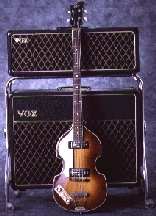


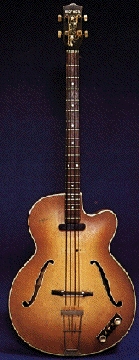

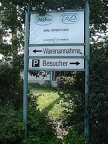
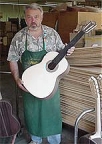
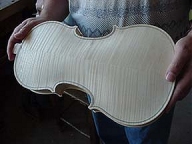
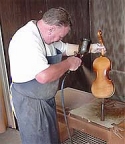
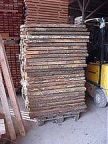
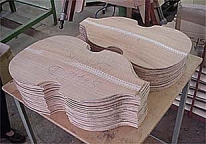
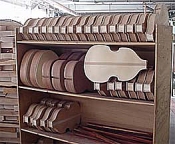
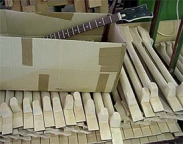
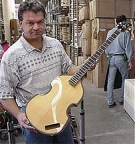
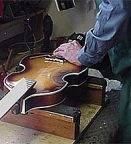

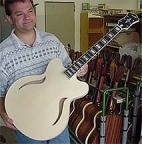
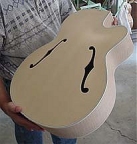
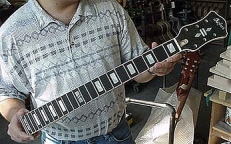
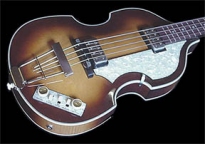
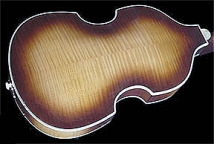
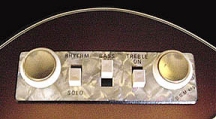
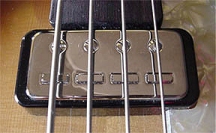
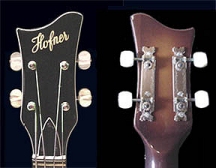

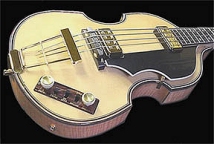
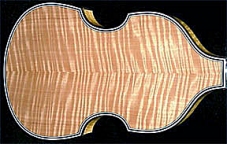
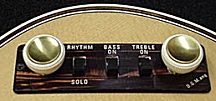

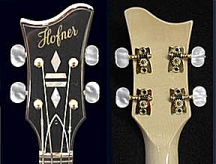
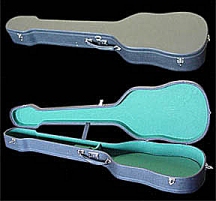
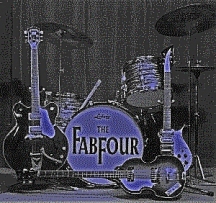
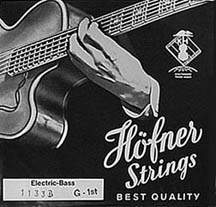
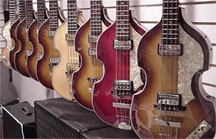
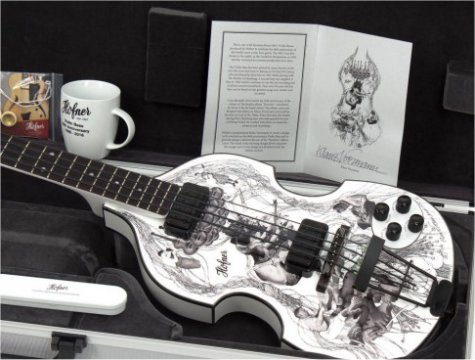

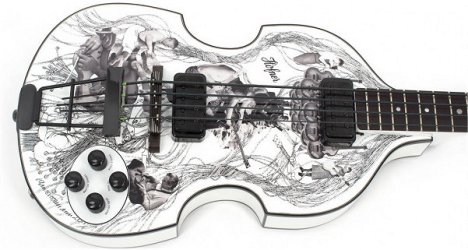
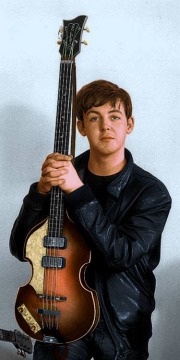 .
.